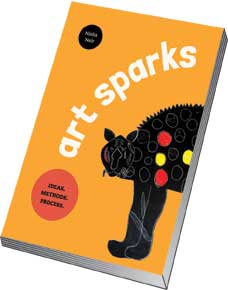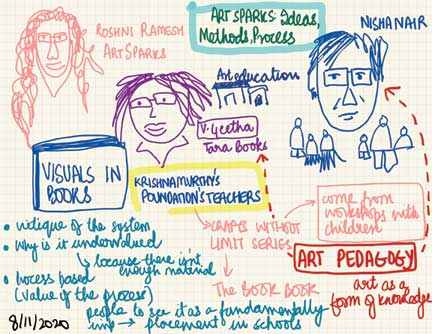Siddhi Gupta

Author: Nisha Nair
Publisher: Tara Books Pvt. Ltd.
Year of Publication: 2020
Pages: 112
Price: Rs 500
I have been on both sides of the table of an art room and relished the experience each time. My hopes as a learner in the art room became my guide as an educator in the same room years later. But as I navigated through these aspirations, the challenges in art education became bare – the lack of resources, attention and importance given to the arts in school, the subservience of arts to other subjects, a do-what-you-feel-like-it-doesn’t-really-matter attitude towards the art class are a few peculiarities about art education that most of us will be aware of. In this reality, Nisha Nair’s Art Sparks is a guiding light for any art teacher looking for a resource to fall back on, a dose of inspiration, a rule book. But it is not just for the art educator, it is for anyone who wishes to explore art as a tool for learning. You can be a STEM educator, a parent, or an adult seeking to learn art.
Nair begins with, what I find is her most powerful argument, the problems associated with ‘how we talk about art’. Our inability to define art cripples its relevance and application in education. In using it interchangeably with drawing, we limit its scope to a skill and accept it as an ability a few of us have, not all. Nair dismantles this notion and seeks to replace it with her outlook of art education as an opportunity to allow learners to explore, experiment and enquire. She elucidates this in the book by taking us through each step of her 12 session programme with thirty two 11-year old learners from a low-cost aided private school situated in a rural village in Karnataka. The steps are clear, crisp and convincing.
Nair repeats at multiple places in different contexts the importance of allowing multiple perspectives to co-exist in the same room. There is immense value in bringing this to any classroom, but the art room in particular. Of all the approaches and processes in the book, if the reader can manage to internalize just this one proposition, it would make a visible and commendable difference.
Art Sparks is conceptual, technical, procedural, visual and holistic. Nair speaks with authority and evidence. She tells you why she is doing what and takes you from day one to the last day, giving you visual insights along the way. Her voice is also complemented with the voices of learners from her group, which come as a welcome addition to the narrative. These accompaniments make Art Sparks more than a lesson plan, it helps you build a foundation which can be adapted to your context and your art room. It is not a one-stop solution, and Nair doesn’t claim it is. However, it is more than a starting point and that is exactly what we need.

Integrating art in education is not easy, it requires perseverance, planning and effort. Nair in dealing with these complexities, supports you but doesn’t dumb it down. At one point in the book she compares the learning process to the artist’s process of making. While finished outcomes of an artist’s works are often introduced in the classroom with attention to some specific techniques, the holistic process is rarely looked at in detail.
There is an acknowledgement to the work that is involved and the benefits it reaps. Policies advocating art education often demonstrate why it is important to include art in education but lack in supplying any actual support to action it in the classroom. This makes the execution of the policy difficult and the impact low. If art in education has to be achieved, then there has to be an acknowledgement of the effort involved because only then will support for this effort be recognized and amplified.
Art Sparks is based in India which makes this an even more important contribution to art education. It reflects our philosophy of learning and addresses some very specific classroom dynamics that are unique to India. It speaks to those who have learned and teach in the Indian classroom – which in itself can mean many different things. As an investigator in the Indian art education landscape, I welcome Nisha Nair’s Art Sparks with its persistence to encourage questioning, belief in unfettered exploration, attention to process rather than the outcome with open arms. It is refreshing, inclusive and original in its approach. Art as a tool for leaning in India is still unexplored and this initiation into its scope is hopefully just the beginning.
The author is an illustrator working at the intersection of education, culture and communication. She is currently the hands and eyes at Kalakarm Curriculum, an initiative that facilitates art in education. She can be reached at
